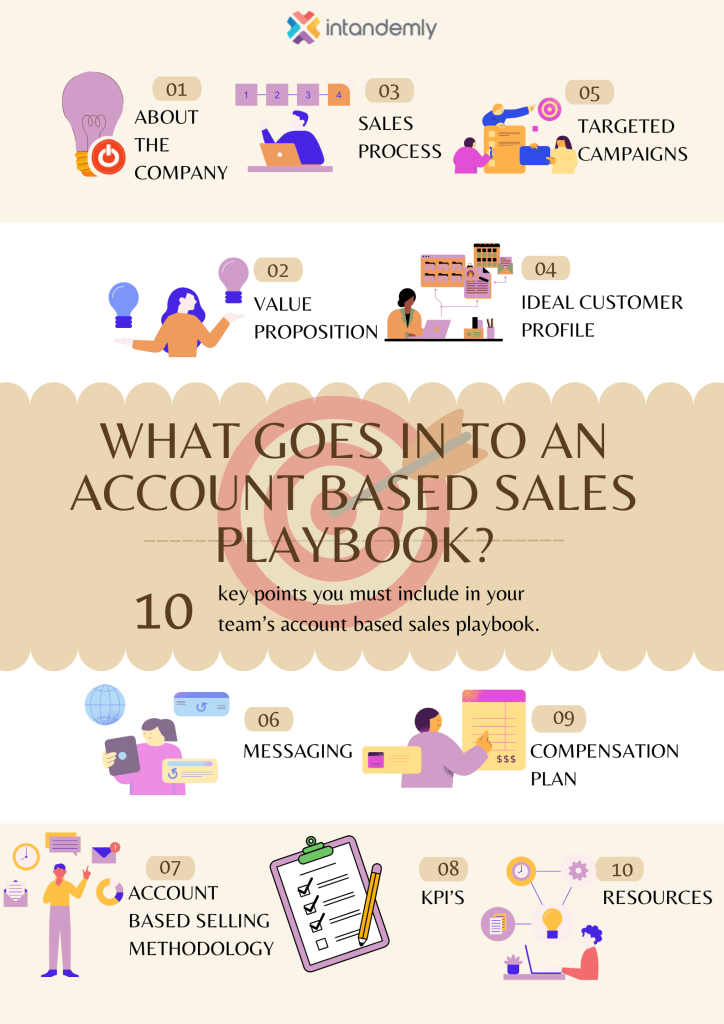What Goes In To an Account Based Sales Playbook
INTRODUCTION:
In today's hyper-competitive business landscape, traditional sales approaches are no longer sufficient to win over high-value clients. As businesses strive to build stronger, more personalized relationships with their prospects, the concept of account-based selling has emerged as a game-changer. Account based selling shifts the focus from individual leads to entire target accounts, allowing sales teams to align their efforts and resources strategically. In this blog post, we will look into what goes into an Account-Based Sales Playbook, exploring its key components and best practices for success.
What is a sales playbook?
A sales playbook is a collection of tactics that outline the characteristics of your sales process; buyer personas; agendas; sample emails; discovery, qualification, demo, and negotiation questions; proposal guidelines; and/or competitive intelligence guidelines.
In other words, your sales playbook helps you standardize and implement your account based selling methodology with all the high-performing content and strategies needed to close a deal.
Why do you need a sales playbook?
Having an account based sales playbook is like having a map at a theme park you know where everything is, you just need to select where you want to go and what you want to do the most.
There are a few unavoidable advantages to having a sales playbook because
- When you hire a new salesperson, training him or her to your company’s product and ABM practices become far easier and faster.
- With a playbook in place you can speed up the sales process as every rep, SDR, VP has content right at their fingerprint and can dedicate more time for selling.
- As everyone within the company follows one sales playbook/practice of messaging will be unified from rep level to CEO.
- Develop the playbook by adding old and new techniques that worked for you in closing a deal, and lessons learned from those which did not work. This helps the salespeople to choose from a variety of options that all worked in the past.
If your sales team doesn’t have a playbook yet, or the existing one is just a thin guide with very little information, it’s time for a change.
Here are the key points you must include in your team’s account based sales playbook.
1) About the company
The crucial part of an account based sales playbook is to have a section talking about your company, culture, goals and organizational structure.
Advantages of having "about the company" in your playbook
- It summarizes the company’s history, giving the reps a high-level understanding of what the kind of culture the company harbors and the goals it aims for.
- Having an overview of the company section gives the reps an understanding of the organizational structure, i.e., the hierarchy of the teams, who to report to, who leads each team, etc.
- Spell out the well-designed career path your salespeople would have in the company, giving them an idea of what milestones to achieve for a promotion, requisite skills or experience for a job, etc.
2) Company Offer / Value Proposition
This section covers every product or service your salespeople are responsible for selling -- their price points, use cases and/or core value offerings, buyers and end users, and related industries or verticals.
Some companies create one sales playbook per product; take this route if your products are different, require radically separate buying processes, and/or are sold by different members of your sales team.
3) Sales Process
Explain each step of your sales process from first connect to close. What are the key activities that define each stage? Who is involved (the rep, their manager, the prospect, the buying authority, etc.)? What are the deliverables?
Integrating all the available data to make informed decisions about targeting, managing and measuring the performance of their efforts is critical in making a switch to account based sales.
4) Ideal Customer Profile
Scoring accounts around several factors, including fit, intent, and engagement so you can see which target accounts you should target and engage.
Sketching out your optimal customer will help your salespeople quickly and efficiently hone in on the most qualified accounts.
Include buyer personas within the account, who they typically report to, their key performance indicators, common challenges, and how much power they have.
In addition, note where they come into play in the buying process; for example, the CTO probably won’t get involved until her team has narrowed the list down to two vendors, while the tech team lead may be communicating with the rep from day one.
This is also a good section to include your qualification criteria, such as “Able to buy within six months” or “Has sufficient budget”.

5) Triggering Targeted Campaigns and Programs
Now that you better understand the target accounts, you should set up triggers to perform different types of activities automatically, helping those accounts move closer to conversion.
Some salespeople have near-total control over the quantity, type, and schedule of their outreach, while others follow a prescribed cadence. The larger and more complex your deals are, the more autonomy salespeople likely have.
In this section, lay out the ideal number, timing, and medium of touches, dynamically targeting the accounts with personalized messages.
Provide some guidelines on when to pursue opportunities and when to let them go.
6) Messaging
In this section (typically one of the largest and most comprehensive), include your sample messaging. That means
- email templates
- positioning statements
- calling
- voicemail scripts
- common objections and how to handle them
- meeting agendas
- presentation decks, and any other prewritten resources your team uses.
Examples: Show your salespeople what a great call sounds like so they can incorporate the takeaways into their own process.
In this section, upload or link to recordings or screencasts of high-quality meetings. Strive for at least one example for each stage, e.g. one connects call recording, two discovery call recordings, three demo recordings, and so on.
7) Account Based Selling methodology
Most companies use at least one sales methodology, from the Challenger Sale to Account-Based Selling. Describe yours here -- what it is, how salespeople should use it, where they can go to learn more, etc.
8) Compensation Plan
The better your reps understand how your pay and commission structure work, the more likely they are to execute on it.
Describe -- in as few words as possible -- what your plan is, including the type of plan (salary only, commission only, base plus bonus, so forth), if you’re doing a traditional base/bonus plan, the percentage base versus bonus; any accelerators/decelerators at play; if you use clawbacks; the quota-setting process; and approximately how often reps can expect sales contests and SPIFs.
To make this section even more comprehensible, consider showing how much a hypothetical rep would make if he hits 50%, 90%, 100%, 110%, and 120% of quota.
9) KPI’s
Which metrics do your company’s sales managers track most closely? Which account should the salesperson be paying attention to?
You should be able to deeply understand and analyze things like customer journeys, where you can see how the accounts interact with your company on the road to conversion.
10) Resources
Reps are always looking for relevant case studies, testimonials, and customer references. Depending on how many of those resources you have -- and how tailored they are -- think about including them in your sales playbook.
Suppose you sell to two main customers: Individual teachers (spending their classroom budgets) and school districts (spending their district budgets).
You’d want at least one case study directed specifically at teachers, like the story of how your product helped one classroom improve test scores by 30%. You’d want another directed at districts, such as the story of the district who implemented your product in all 10 of its schools and became one of the top-performing of its size in the state.
Having on-demand, easily accessible material means reps can easily incorporate it into their sales process, improving their close rates (and decreasing the likelihood they’ll go rogue and use content they’ve created on their own).
Key Takeaways
As your sales process changes and improves, your product line expands or shrinks, your ideal customer profile shifts, your strategy evolves, and your sales compensation plan is tweaked, update your sales playbook accordingly.
Doing so is easiest if your playbook is online and accessible to your entire team at any time. You can use sales content software or a group Google Drive -- whatever works for you and your budget.
When you make a major change, like adding or revamping a section, give your team the heads up. Announce the update in your team meeting, weekly or monthly email newsletter, and/or Slack channel.
Follow these guidelines to build a strong, executable account based selling playbook. Your reps will appreciate it … and so will your results.
Key components and best practices for success
- Comprehensive Account Research and Profiling
At the core of account-based selling lies the in-depth understanding of your target accounts. Start by identifying your ideal customer profiles and key decision-makers within each account. Comprehensive research on the company's pain points, challenges, and growth opportunities will empower your sales team with valuable insights to tailor their approach effectively.
- Defining Clear Objectives and Goals
Before you start engaging with target accounts, establish clear and measurable objectives for each. Define your sales team's goals, such as revenue targets, upselling opportunities, or long-term account retention. Setting specific and realistic goals will help your team stay focused and aligned throughout the process.
- Personalized Outreach Strategies
Account-based selling thrives on personalization. Instead of using generic sales pitches, craft tailored messages for each account that address their unique pain points and aspirations. This personalized approach demonstrates your commitment to understanding their needs and positions you as a trusted partner, increasing the likelihood of successful conversions.
- Collaborative Sales and Marketing Alignment
A successful account-based sales playbook requires seamless collaboration between sales and marketing teams. Marketing should support sales efforts with targeted campaigns, content, and account-specific materials. Regular meetings and open communication channels are vital to align both teams towards a unified goal.
- Utilizing Multi-Channel Engagement
Diversify your outreach methods to effectively engage with target accounts. Combine personalized emails, social media interactions, phone calls, and personalized direct mail to create a multi-channel approach. Each channel complements the other, increasing your chances of connecting with key decision-makers.
- Implementing Account-Based Sales Technology
Leverage technology to streamline and enhance your account-based sales efforts. Account based selling platforms, customer relationship management (CRM) systems, and sales automation tools can help sales teams track interactions, gather data, and identify actionable insights to improve engagement strategies.
- Nurturing Long-Term Relationships
Account based selling is about building enduring relationships with your customers. It is not just about the initial sale; it's also about understanding their evolving needs and providing ongoing value. Cultivate a customer-centric approach and prioritize post-sale engagement to foster loyalty and encourage advocacy.
- Continuous Analysis and Optimization
Regularly analyze the performance of your account based selling playbook to identify strengths, weaknesses, and areas for improvement. Measure key metrics such as conversion rates, deal sizes, and customer lifetime value. Use these insights to refine your strategies and optimize your playbook for even greater success.
CONCLUSION:
Account based selling is a powerful approach that enables businesses to forge meaningful connections with high-value accounts. By creating a comprehensive Account based Selling Playbook that emphasizes personalization, collaboration, and continuous improvement, your sales team can unlock the full potential of account based selling. Embrace this customer-centric methodology, and your organization will be better positioned to thrive in today's competitive business landscape.






![Content Marketing Trends-2024 [Comprehensive Guide]](https://www.intandemly.com/wp-content/uploads/2016/07/content-marketing-blog-banner-50x50.png)

